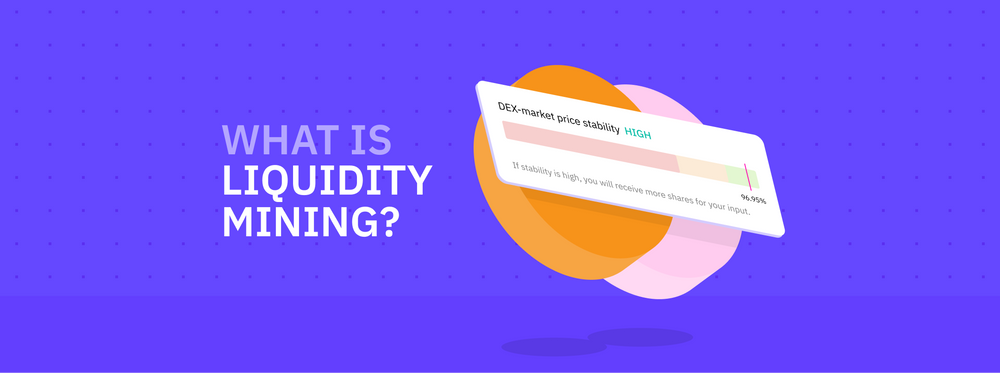Decentralized Finance, or DeFi, has become a buzzword in cryptocurrency and blockchain technology. One of the most significant innovations in DeFi is liquidity mining, a process that allows users to earn rewards for providing liquidity to decentralized exchanges and other DeFi platforms.
Liquidity mining has revolutionized the traditional financial system by enabling anyone to earn interest and rewards without intermediaries like banks. This article will explore what DeFi liquidity mining is, how it works, and its potential benefits and risks.

Table of Contents
DeFi liquidity mining
DeFi liquidity mining is a process of earning rewards for providing liquidity to decentralized finance (DeFi) platforms. It involves depositing cryptocurrencies into a smart contract and facilitating trades on decentralized exchanges.
By providing liquidity, users can earn rewards through new tokens or fees from trades. Liquidity mining has become a popular way for users to earn passive income on their cryptocurrency holdings while also helping increase DeFi platforms’ liquidity. However, liquidity mining has risks, including impermanent loss and potential market volatility.
How does DeFi liquidity mining work?
DeFi liquidity mining incentivizes users to deposit their cryptocurrency holdings into a liquidity pool on a decentralized exchange or other DeFi platform. Liquidity pools are smart contracts holding reserves of different cryptocurrencies, allowing users to trade between them without intermediaries like traditional exchanges.
To participate in liquidity mining, users must deposit equal values of two different cryptocurrencies into the liquidity pool. These two cryptocurrencies are often called “liquidity pairs,” Their value determines the share of the liquidity pool the user holds. The user then receives a corresponding share of the transaction fees generated by the liquidity pool.
In addition to transaction fees, many DeFi platforms also offer incentives in the form of new tokens or rewards for participating in liquidity mining. These rewards can be distributed differently, based on the user’s share of the liquidity pool or a fixed amount given to all liquidity providers.
Liquidity mining can be a profitable way to earn passive income on cryptocurrency holdings, but it also carries risks. One of the main risks is impermanent loss, which occurs when the value of one cryptocurrency in the liquidity pair changes significantly compared to the other. This can result in a loss of value for the liquidity provider, despite earning rewards from transaction fees.
DeFi liquidity mining is a complex but potentially lucrative way to participate in the growing world of decentralized finance. It requires careful consideration of risks and rewards and a thorough understanding of the specific platform and liquidity pool being used.
How to Start Liquidity Mining
Starting liquidity mining can be profitable for earning passive income on cryptocurrency holdings. Still, it requires careful consideration of risks and rewards and a thorough understanding of the specific platform and liquidity pool being used. Here are some steps to get started with liquidity mining:
Choose a DeFi platform
Many DeFi platforms are available for liquidity mining, each with its own rewards and risks. Research and choose a platform that suits your investment goals and risk tolerance.
Select a liquidity pool
Once you have chosen a platform, select a liquidity pool that fits your investment strategy. Look for pools that have high trading volumes and low fees.
Deposit your cryptocurrency
To participate in liquidity mining, you must deposit equal values of two different cryptocurrencies into the liquidity pool. These two cryptocurrencies are often called “liquidity pairs,” and their value determines the share of the liquidity pool you hold.
Start earning rewards
Once you have deposited your cryptocurrency into the liquidity pool, you will start earning rewards through transaction fees and other incentives offered by the DeFi platform.
Monitor your investment
Liquidity mining involves risks such as impermanent loss and market volatility. Keep a close eye on your investment and be prepared to adjust your strategy if necessary.
Benefits of DeFi Liquidity Mining
Defi liquidity mining offers several benefits to users, including:
- Passive income: Liquidity mining allows users to earn passive income on their cryptocurrency holdings by providing liquidity to DeFi platforms. This can be attractive for investors looking to generate returns without actively trading.
- Higher returns: Liquidity mining can offer higher returns than traditional savings accounts or other investment options. Users may earn rewards through transaction fees, new tokens, or other incentives depending on the platform and liquidity pool.
- Increased liquidity: By providing liquidity to DeFi platforms, users help increase their liquidity, making it easier for others to trade cryptocurrencies.
- Access to new tokens: Many DeFi platforms offer rewards in the form of new tokens, which may have the potential for significant value appreciation over time.
- Decentralized control: DeFi liquidity mining allows users to participate in a decentralized financial system not controlled by centralized authorities like traditional banks.
- Flexibility: Liquidity mining offers flexibility regarding the amount of cryptocurrency users can deposit, the liquidity pool they choose, and the duration of their participation.
Risks of DeFi Liquidity Mining
While DeFi liquidity mining can offer potential rewards, there are also several risks to consider, including:
- Impermanent loss: Impermanent loss occurs when the value of one cryptocurrency in the liquidity pair changes significantly compared to the other. This can result in a loss of value for the liquidity provider, despite earning rewards from transaction fees.
- Smart contract risks: DeFi platforms are powered by smart contracts, which are subject to bugs and vulnerabilities that could potentially result in the loss of funds.
- Market volatility: Like all investments, cryptocurrency prices can be highly volatile, which can impact the liquidity pool’s value and the rewards liquidity providers earn.
- Liquidity risks: If there is low trading volume in the liquidity pool, it can be easier to withdraw funds from the pool, resulting in decreased liquidity and potential loss of funds.
- Regulatory risks: DeFi is still largely unregulated, which means there is a risk of regulatory changes that could impact the profitability of liquidity mining or even shut down the platform.
Is DeFi Liquidity Mining Worth It?
Whether or not DeFi liquidity mining is worth depends on individual investment goals and risk tolerance. While liquidity mining can offer potential rewards such as passive income, higher returns, increased liquidity, and access to new tokens, there are also several risks to consider, such as impermanent loss, intelligent contract risks, market volatility, liquidity risks, regulatory risks, and scams.
Investors should carefully research the platform and liquidity pool they plan to use, be prepared to monitor their investment closely, and adjust their strategy as needed. Investing in what one can afford to lose and diversifying one’s investment portfolio to mitigate risks is essential.
Ultimately, whether or not to participate in DeFi liquidity mining is personal and should be based on a thorough understanding of the risks and rewards, as well as individual investment goals and risk tolerance.
The Bottom Line
DeFi liquidity mining is a new investment strategy that allows users to earn passive income by providing liquidity to DeFi platforms. While it can offer potential rewards, it is essential to carefully consider the risks and rewards before participating and to make an informed decision based on individual investment goals and risk tolerance.

An experienced leader in software engineering and technology, I’ve driven value for top-tier Fortune 100 and 500 clients as the former CTO of Big Drop Inc. Overseeing a global team, we secured 34 global awards for pioneering web design using our proprietary tech. As the Co-Founder of Motion Design School, I created an innovative platform for global artists. Now, I apply my expertise to the dynamic world of blockchain, leveraging years of experience to shape decentralized technology’s future.